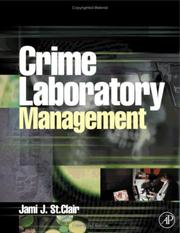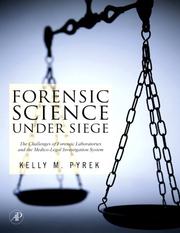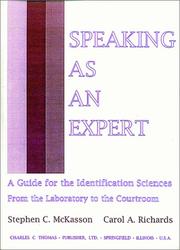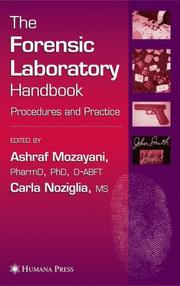| Listing 1 - 9 of 9 |
Sort by
|
Book
ISBN: 0128013621 0128012374 9780128013625 9780128012376 Year: 2018 Publisher: London, England : Academic Press,
Abstract | Keywords | Export | Availability | Bookmark
 Loading...
Loading...Choose an application
- Reference Manager
- EndNote
- RefWorks (Direct export to RefWorks)
Crime laboratories --- Management. --- Forensic laboratories --- Forensic sciences laboratories --- Laboratories

ISBN: 1281005606 9786611005603 0080490840 9780080490847 9781281005601 0126640513 Year: 2002 Publisher: New York Academic
Abstract | Keywords | Export | Availability | Bookmark
 Loading...
Loading...Choose an application
- Reference Manager
- EndNote
- RefWorks (Direct export to RefWorks)
Crime Laboratory Management is the first book to address the unique operational, administrative, and political issues involved in managing a forensic laboratory. It guides managers and supervisors through essential tasks ranging from hiring and training of staff to quality control, facilities management, and public relations. Author Jami St. Clair has more than 20 years experience in forensic science and served as President of the American Society of Crime Lab Directors in 1998-1999. She and her colleagues have designed this book to be useful for supervisors at every level. Wi
Crime laboratories --- Forensic laboratories --- Forensic sciences laboratories --- Laboratories --- Management.

ISBN: 0123708613 9780123708618 9780080471075 0080471072 1280962801 9781280962806 9786610962808 6610962804 Year: 2007 Publisher: Amsterdam Boston Elsevier / Academic Press
Abstract | Keywords | Export | Availability | Bookmark
 Loading...
Loading...Choose an application
- Reference Manager
- EndNote
- RefWorks (Direct export to RefWorks)
Forensic science laboratories' reputations have increasingly come under fire. Incidents of tainted evidence, false reports, allegations of negligence, scientifically flawed testimony, or - worse yet - perjury in in-court testimony, have all served to cast a shadow over the forensic sciences. Instances of each are just a few of the quality-related charges made in the last few years. Forensic Science Under Siege is the first book to integrate and explain these problematic trends in forensic science. The issues are timely, and are approached from an investigatory, yet scholarly
Crime laboratories --- Evidence, Expert --- Forensic sciences --- Forensic scientists --- Scientists --- Forensic laboratories --- Forensic sciences laboratories --- Laboratories
Book
ISBN: 1593325959 9781593325954 9781593325787 1593325789 Year: 2012 Publisher: El Paso LFB Scholarly Pub.
Abstract | Keywords | Export | Availability | Bookmark
 Loading...
Loading...Choose an application
- Reference Manager
- EndNote
- RefWorks (Direct export to RefWorks)
Buker tells the untold story of crime labs. Through extensive field research he scrutinizes the problem of malpractice in the US publicly-funded crime labs from an administrative perspective. Several examples of malpractice in these organizations reflect not only individual mishaps of forensic scientists working in these labs, but also organizational failures. Buker finds that elements of organizational environment and organizational behavior of the crime labs combine to create this organizational failure. He concludes with public policy suggestions to maintain and amplify the trustworthiness
Crime laboratories --- Malpractice --- Evidence, Criminal --- Criminal investigation --- Forensic laboratories --- Forensic sciences laboratories --- Laboratories

ISBN: 0398082693 9780398082697 0398068402 9780398068400 0398068410 9780398068417 Year: 1998 Publisher: Springfield, Ill. Charles C. Thomas
Abstract | Keywords | Export | Availability | Bookmark
 Loading...
Loading...Choose an application
- Reference Manager
- EndNote
- RefWorks (Direct export to RefWorks)
This is an extremely practical book whose purpose is to justify identification, identification science, and expert testimony in identification by discussing the theory of the science while demonstrating its applications. Chapter 1 details the logical course of the text and explains the needs for such a text. Chapter 2 elaborates the nature of identification and identification sciences. Chapter 3 abstracts the essential elements of identification science. Chapter 4 uses the lessons derived from the previous chapters to explore their application in identification research, and Chapter 5 interpre

ISBN: 9781588294647 1588294641 9781592599462 9786610358090 1280358092 159259946X Year: 2006 Publisher: Totowa, N.J. : Oxford : Humana ; Blackwell [distributor],
Abstract | Keywords | Export | Availability | Bookmark
 Loading...
Loading...Choose an application
- Reference Manager
- EndNote
- RefWorks (Direct export to RefWorks)
The image of forensic science as projected by popular film, television, and print media often fails to convey accurately the reality of the work and its potential for finding the truth. In The Forensic Laboratory Handbook: Procedures and Practice, prominent forensic experts explain in simple language the capabilities and limitations of modern forensic laboratory procedures, techniques, analyses, and interpretations. Here, interested readers will find an understandable and fascinating introduction to the complex worlds of forensic serology, DNA, chemistry, crime reconstruction, digital evidence, explosives, arson, fingerprints, firearms, tool marks, odontology, and pathology. Additional chapters address the problems of quality assurance and trace evidence analysis, document examination, and toxicology in the forensic laboratory. Timely and realistic, The Forensic Laboratory Handbook: Procedures and Practice not only illuminates the difficult but fascinating work performed in the real forensic laboratory, but also details the practical procedures forensic scientists employ in their day-to-day work.
Forensic Medicine --- Forensic Sciences --- Crime laboratories. --- Forensic sciences. --- Criminalistique --- Handbooks. --- Crime laboratories -- Handbooks, manuals, etc. --- Crime laboratories --- Forensic sciences --- Criminology --- Social Problems --- Social Sciences --- Sociology --- Anthropology, Education, Sociology and Social Phenomena --- Crime --- Public Health --- Social Welfare & Social Work --- Health & Biological Sciences --- Criminology, Penology & Juvenile Delinquency --- Legal & Forensic Medicine --- Criminalistics --- Forensic science --- Forensic laboratories --- Forensic sciences laboratories --- Medicine. --- Forensic medicine. --- Medicine & Public Health. --- Forensic Medicine. --- Science --- Criminal investigation --- Laboratories --- Forensic medicine --- Injuries (Law) --- Jurisprudence, Medical --- Legal medicine --- Medicine --- Medical laws and legislation --- Medical jurisprudence.
Book
ISBN: 9781607618720 1607618729 1607618710 9781607618713 9786613080622 1283080621 Year: 2011 Publisher: Totowa, NJ Humana Press
Abstract | Keywords | Export | Availability | Bookmark
 Loading...
Loading...Choose an application
- Reference Manager
- EndNote
- RefWorks (Direct export to RefWorks)
Forensic science has come a long way in the past ten years. It is much more in-depth and much broader in scope, and the information gleaned from any evidence yields so much more information than it had in the past because of incredible advances in analytic instruments and crucial procedures at both the crime scene and in the lab. Many practices have gone digital, a concept not even fathomed ten years ago. And from the first collection of evidence to its lab analysis and interpretation to its final presentation in court, ethics has become an overriding guiding principle. That’s why this new edition of this classic handbook is indispensable. The Forensic Laboratory Handbook Procedures and Practice includes thirteen new chapters written by real-life practitioners who are experts in the field. It covers the tried and true topics of fingerprints, trace evidence, chemistry, biology, explosives and arson, forensic anthropology, forensic pathology, forensic documents, firearms and toolmarks. This text also addresses an array of new topics including accreditation, certification, ethics, and how insects and bugs can assist in determining many facts including a margin of time of death. In the attempt to offer a complete and comprehensive analysis The Forensic Laboratory Handbook Procedures and Practice also includes a chapter discussing the design of a laboratory. In addition, each chapter contains educational requirements needed for the discipline it covers. Complete with questions at the end of each chapter, brief author bios and real crime scene photos, this text has risen to greet the many new challenges and issues that face today’s forensic crime practitioners.
Legal medicine --- medische laboratoriumtechnologie --- gerechtelijke laboratoria --- gerechtelijk onderzoek --- gerechtelijke geneeskunde --- Crime laboratories. --- Forensic sciences. --- Criminalistics --- Forensic science --- Science --- Criminal investigation --- Forensic laboratories --- Forensic sciences laboratories --- Laboratories
Book
ISBN: 0124104193 0124166938 9780124104198 9780124166936 Year: 2014 Publisher: Oxford, [England] ; San Diego, California : Academic Press,
Abstract | Keywords | Export | Availability | Bookmark
 Loading...
Loading...Choose an application
- Reference Manager
- EndNote
- RefWorks (Direct export to RefWorks)
Forensic Document Examination enlightens forensic document examiners, forensic investigators, attorneys, and others using the services of forensic document examiners with basic principles, current trends in the area, and standards and methodologies which were non-existent 20 years ago. Instrumentation has moved beyond the microscope and the magnifying glass to digital cameras, digital microscopes, video spectral comparators, electrostatic detection devices for the development of indented writing on paper, scanners, and software programs like Write-On 2® and Photoshop®. All of this equipment an
Crime laboratories -- Planning. --- Identification cards -- Forgeries -- Identification. --- Legal documents -- Identification. --- Legal documents --- Writing --- Evidence, Documentary --- Social Welfare & Social Work --- Social Sciences --- Criminology, Penology & Juvenile Delinquency --- Identification --- Identification cards --- Crime laboratories --- Identification. --- Forgeries. --- Planning. --- Forensic laboratories --- Forensic sciences laboratories --- Laboratories --- Fake identification cards --- Forged identification cards --- Forgery of identification cards --- Phony identification cards --- Documents, Identification of --- Identification of documents --- Criminal investigation
Periodical
ISSN: 20961790 24711411 Publisher: Taylor & Francis Group
Abstract | Keywords | Export | Availability | Bookmark
 Loading...
Loading...Choose an application
- Reference Manager
- EndNote
- RefWorks (Direct export to RefWorks)
'Forensic Sciences Research' is an open access international, peer-reviewed journal publishing high-quality, original research and is an official journal of the Academy of Forensic Science (AFS).
forensic sciences --- clinical forensic medicine --- crime scene investigation --- Forensic Sciences. --- Jurisprudence. --- Forensic sciences --- Medical jurisprudence --- Criminals --- Crime laboratories --- Crime laboratories. --- Forensic sciences. --- Medical jurisprudence. --- Identification --- Identification. --- Forensic medicine --- Injuries (Law) --- Jurisprudence, Medical --- Legal medicine --- Medicine --- Medical laws and legislation --- Criminalistics --- Forensic science --- Science --- Criminal investigation --- Forensic laboratories --- Forensic sciences laboratories --- Laboratories --- Crime and criminals --- Delinquents --- Offenders --- Persons --- Crime --- Criminal justice, Administration of --- Criminology --- Constitutional Law --- Court Decision --- Law --- Legal Aspects --- Legal Obligations --- Legal Status --- State Interest --- Litigation --- Medical Jurisprudence --- Aspect, Legal --- Aspects, Legal --- Constitutional Laws --- Court Decisions --- Decision, Court --- Decisions, Court --- Interest, State --- Interests, State --- Law, Constitutional --- Laws --- Laws, Constitutional --- Legal Aspect --- Legal Obligation --- Litigations --- Obligation, Legal --- Obligations, Legal --- State Interests --- Status, Legal --- Defamation --- Lawyers --- Forensic Science --- Science, Forensic --- Sciences, Forensic --- Criminology, Penology & Juvenile Delinquency --- Human medicine
| Listing 1 - 9 of 9 |
Sort by
|

 Search
Search Feedback
Feedback About UniCat
About UniCat  Help
Help News
News